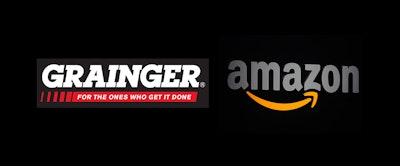
This week, Grainger formally and publicly announced the launch of its newest e-commerce offering, Gamut.com, as part of its effort to stave off disruption from Amazon Business and pursue digital transformation.
After a thorough exploration of the site and listening to Grainger’s executives, it’s clear that the company is misstepping with Gamut and really needs to reevaluate its approach to e-commerce and the future of its business. Otherwise, the company will continue to miss earnings targets and cost its investors billions more in share value.
Why Gamut Won’t Save Grainger From Amazon Business
Grainger’s Gamut strategy shows that its e-commerce approach is well behind the competition.
For one, Gamut is a separate site from Grainger’s core business. Owning multiple online properties that are selling essentially the same thing to the same people is extremely inefficient and unsustainable. By continuing to split its business into multiple “single-channel” sites, Grainger loses any real scale advantages it has compared to competitors.
This multi-site approach doesn’t work well because it splits the traffic and data. Rather than delivering the Grainger experience to every customer, it mixes the messaging and creates inconsistencies, which are readily apparent. For example, there are many significant price discrepancies between Grainger, Gamut, and Zoro.
Gamut also has a radically smaller product catalog to start, with assurances that Grainger’s full offerings will be integrated to Gamut over time.
Second, this strategy speaks to a lack of technical sophistication at Grainger.
Amazon itself tried the separate-site approach in 2012 with AmazonSupply, the precursor to Amazon Business. AmazonSupply lived at a separate URL, amazonsupply.com, and had a user experience that was different than the core Amazon site. But within a few years, Amazon decided to shift to an integrated site, with both Amazon Business and Amazon’s consumer site living side-by-side at the same URL, amazon.com.
In other words, Grainger’s technical roadmap is at least five years behind Amazon’s. This separate-site approach makes sense, but Grainger is a half-decade behind the competition in taking B2B e-commerce seriously. Splitting out separate properties to test out new ideas and see what works would have made sense ages ago.
Today, it’s just another sign that Grainger is far behind its main competition.
That the company is touting Gamut as some kind of gamechanger only gives more reason to doubt that Grainger can stop its decline. More technically sophisticated competitors like Amazon have long since moved past the prototyping and testing phase and are now scaling rapidly. Grainger isn’t even playing catch up – it appears to still be Grainger testing the waters.
Fighting an Unwinnable Battle
In the launch’s press release, Gamut’s president, Brian Walker, said “The technology behind Gamut.com provides a new way to help customers find exactly what they need along with associated product suggestions in a simplified – but complete – experience.” Grainger’s executives have made similar statements touting Gamut’s more sophisticated search technology.
Yet after digging into Gamut, its technology doesn’t seem like a game changer. Amazon’s search and recommendations systems are still far ahead of anything Gamut has to offer.
In fact, our engineering lead (formerly of Amazon’s recommendations team) tested Gamut’s search capabilities and found them to be severely lacking, paling in comparison to Amazon’s search power.
decline to get worse.
 Gamut’s technical sophistication seems to be lacking. (Applico)
Gamut’s technical sophistication seems to be lacking. (Applico)Amazon has decades of user data to examine and utilize for making better business and design decisions. As well, the company has extremely sophisticated algorithms for recommending additional items for purchase, which some estimates claim is accountable for some 35 percent of Amazon’s revenue.
Recommendation systems also personalize the customer experience, improving the company’s brand, and they can take a lot of the heavy lifting off of the operating costs.
Recommendations and search are a huge part of e-commerce success, and Gamut doesn’t offer anything that makes us think it will help Grainger catch up to Amazon in this area.
Branding Is Everything
To make matters worse, Gamut strips away the branding for all of its inventory until the customer is ready to make a purchase and is looking at pricing information. Providing access to the top and most reliable brands was one of Grainger’s few cited advantages for standing up to Amazon.
Grainger CEO D.G. Macpherson has previously stated that the lack of manufacturer branding wouldn’t get in the way of customers and manufacturers obtaining value from a relationship with the company.
This view doesn’t make any sense. Grainger’s value proposition to its customers is driven by brand value. Treating products like commodities as Gamut does works strongly in Amazon’s favor. Amazon excels at moving commodity goods where consumers are focused on selection and price over brand.
If Grainger stands any chance against Amazon, emphasizing brands, rather than hiding them, is the way to go.
Even Amazon offers large B2B brands rich branding opportunities on Amazon Business. In addition to product listings, Amazon lets bigger companies add rich content including banner images, videos and social media links to make their brand store stand out.
 Bosch Power Tools has a very well-branded page on Amazon Business. (Applico)
Bosch Power Tools has a very well-branded page on Amazon Business. (Applico)Big brands like Bosch have pages on Amazon Business that could practically replace most company’s e-commerce sites. Gamut’s brand-free approach stands in stark contrast to Amazon’s efforts to add brand presences to its marketplace.
And given Grainger’s strategic advantage when it comes to brands, this approach doesn’t make much sense. Why cede the main advantage you have over your competition?
Still Not a Marketplace
The biggest reason not to believe in Gamut is that it shows Grainger hasn’t fundamentally changed its e-commerce approach.
Like Grainger, Gamut acts as a reseller. This approach means Gamut will keep the inventory on its balance sheet and be limited by the products it can stock and sell on its own.
Meanwhile, Amazon’s growth is being fueled by third-party sellers listing their products on the marketplace and fulfilling the orders themselves. These sellers are driven by a low-cost point of access to new customers, with little sales or marketing needed.
Amazon makes its money by offering sellers services to support the transactions and by collecting a portion of every transaction. It also directly sells a handful of key items itself.
This hybrid reseller-marketplace approach is the same recipe that drove Amazon’s success in B2C. So far, it appears to be doing just as well in B2B.
As Amazon’s B2B marketplace grows, both smaller sellers and consumers win. Grainger and other large distributors do not.
Without that army of third-party sellers, Gamut and Grainger will inevitably be surpassed by the catalog depth and price competitiveness that Amazon Business will offer. The economics simply favor marketplaces.
Given the success and growth of Amazon Business, It doesn’t make sense that Grainger isn’t even considering the marketplace approach. If Grainger truly wants to experiment with a separate site, it should be focused on a building a marketplace, not yet another e-commerce property.
 Alex Moazed, Founder & CEO of Applico, Author of 'Modern Monopolies'
Alex Moazed, Founder & CEO of Applico, Author of 'Modern Monopolies'With the current strategy, It’s unclear how Grainger plans to recover the $2 billion it lost its investors since its earnings call last April. Gamut just doesn’t appear to move the needle — it’s just another reseller website, which brings about more difficulties than benefits for customers and will be another cost on Grainger’s books to recoup and manage.
Marketplaces work, even in B2B. If Grainger only continues to double down on the same failing strategy, expect its decline to get worse.
Alex Moazed is the CEO of Applico, which he founded with credit cards in college. He advises Fortune 500 companies on platform innovation and combating the threat of marketplaces. He has developed more than 350 apps and co-authored the bestselling book Modern Monopolies.






















